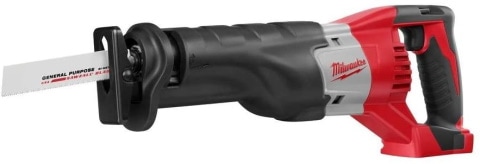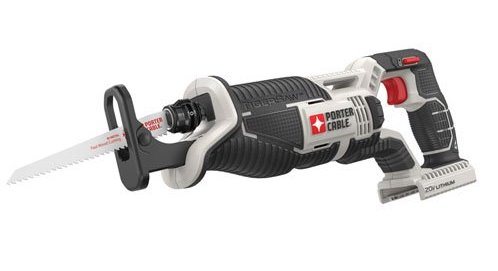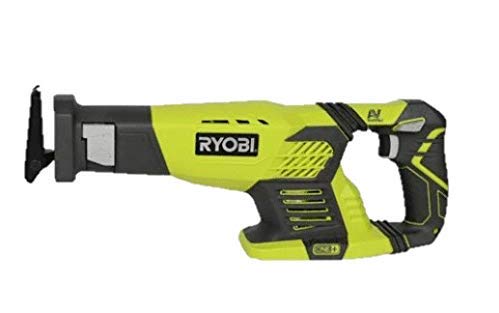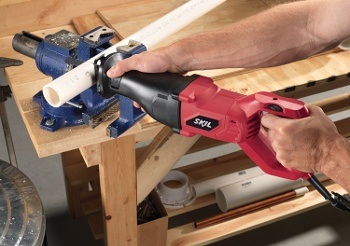6 Best Cordless Reciprocating Saws of 2025 – Reviews & Buying Guide
-
Pete Ortiz
- Last updated:

Reciprocating saws can be used for deconstruction as well as for precise cuts. The combination of a cordless power source with this flexible cutting tool makes sense. There’s no point being restricted to the five-foot circle around a plug socket or having to lug a power reel from one piece of wood to the next, but just because you’re going cordless doesn’t mean you should sacrifice power or quality.
Unfortunately, not all cordless reciprocating saws are worth your while but we’ve compiled a list of the best cordless reciprocating saws, including a list of what we like and what we don’t like about each so that you can choose the right model, no matter the application.
A Quick Comparison of Our Winners (updated in 2025)
| Rating | Image | Product | Details | |
|---|---|---|---|---|
Best Overall

|

|
DeWalt DCS387B Cordless Reciprocating Saw |
|
CHECK PRICE |

|

|
Milwaukee 2620-20 Battery Reciprocating Saw |
|
CHECK PRICE |
Best Value

|
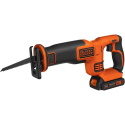
|
BLACK+DECKER BDCR20C Cordless Sawzall |
|
CHECK PRICE |
|
|
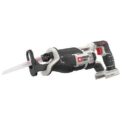
|
PORTER-CABLE PCC670B Battery Reciprocating Saw |
|
CHECK PRICE |
|
|

|
Ryobi P514 18V Cordless Reciprocating Saw |
|
CHECK PRICE |
The 6 Best Cordless Reciprocating Saws
1. DeWalt DCS387B Cordless Reciprocating Saw – Best Overall
DeWalt has an excellent reputation for producing high quality and durable tools and power tools, and the DCS387B cordless reciprocating saw is no different. It is a lightweight model, weighing in at just under 5.5 pounds and it has variable speed settings up to 2,900 SPM (strokes per minute).
Despite being smaller than most of the other models in this list, the DCS387B is powerful and its small form means that it can fit into some of the tightest spaces. The lightweight and small form also mean that you can comfortably lift and use this saw for hours without straining your muscles, even when using it with one hand. Comfort is also ensured through the addition of a soft-grip handle and the motor is installed in front of the trigger at a 45-degree angle which means that the center of gravity feels just right in the hand.
Considering this is one of the lightest and smallest models on the market, it does not compromise in power or comfort and retains a modest price tag, which is why it is our pick as the best cordless reciprocating saw. If we were being picky, we would have preferred a brushless motor for improved performance and reduced heat.
- Variable speed settings
- Lightweight and small form
- Great motor position for weight distribution
- Not brushless
2. Milwaukee 2620-20 Battery Reciprocating Saw
The Milwaukee 2620-20 reciprocating saw has an 18-volt battery that can offer up to 3,200 SPM via the variable speed settings. There’s also a battery gauge that alerts you when it is time to charge the battery, ensuring that you don’t run out of power when you need it most.
It weighs 7.4 pounds so it’s quite a bit heavier than the DeWalt, though, and the rubber column in the center of the unit can make it difficult to see your cutting line.
It does have a soft-grip handle, ensuring comfortable use, and the QUIK-LOK blade clamp system means that blades can be swapped quickly and easily without the need for any tools or keys. Like the DeWalt, there really isn’t much to fault about this saw, but it failed to take the top spot because it weighs 2 pounds more, which makes a difference when tackling bigger jobs.
- QUIK-LOK blade clamp system
- Variable speed up to 3,200 SPM
- Battery gauge
- Expensive
- Heavy
3. BLACK+DECKER BDCR20C Cordless Sawzall – Best Value
The BLACK+DECKER BDCR20C is a powerful but cheap reciprocating saw with some good features. It has an efficient 20-volt battery delivering speeds of up to 3,000 SPM and it has dampening technology that virtually eliminates the vibration that a lot of these saws can suffer from. It is also designed to work in extreme temperature conditions, so it makes a beneficial addition to a professional toolbox while the price tag better suits the home user.
The BDCR20C only weighs 4½ pounds but its stroke length of ⅞-inch is shorter than that of either of the options above and most alternative models and has kept it away from the top overall positions. However, it deserves the accolade of best cordless reciprocating saw for the money because it combines some great features with a competitively low price.
Black+Decker includes a tool-free blade changing system, and this is one of the range of tools that uses the same holistic 20-volt battery system so, in theory, a single battery can be used for all of your power tools that utilize this system.
- Great price
- Lightweight saw at 4½ lbs
- Vibration dampening technology
- Tool-free blade change
- Short ⅞” stroke length
- Somewhat bulky design
4. PORTER-CABLE PCC670B Battery Reciprocating Saw
The Porter-Cable PCC670B is a lightweight and portable reciprocating saw. It uses the company’s 20V Max System, which means that it is compatible with the batteries from any of these devices. It has a variable speed trigger up to 3,000 SPM and is another model that includes a tool-free blade changing system for greater convenience and easier use. At just 4 pounds, it is one of the lightest models on the market and because it has a one-inch blade, it makes light and quick work of most jobs.
Unfortunately, a number of buyers have complained that it vibrates more than other models and is not considered suitable for heavy-duty or professional use. For cutting up trees and hacking away at undergrowth, it is more than powerful enough. There have also been some complaints that the blade does not sit snugly in the saw itself which can be unnerving for the user.
- Tool-free blade change
- Variable power setting
- 1” cutting blade
- Very light
- Not for heavy-duty use
- Blade could be tighter
5. Ryobi P514 18V Cordless Reciprocating Saw
The Ryobi P514 18V reciprocating saw has a lot going for it. It weighs 4 pounds and has a variable speed setting and the 18V battery can offer speeds up to 3,100 SPM. Its handle is not only designed to be non-slip and provides a comfortable grip, but it also minimizes the vibrations that you receive when working.
If you already own a Ryobi with an 18V battery, you can also use this with the P514 because it is backward compatible with older batteries. The Ryobi also has an attractive price tag, which is always appealing and is good value for the money it costs. It could do with a more powerful motor, however.
- Cheap
- Lightweight and portable
- Compatible with other Ryobi batteries
- Needs a bit more power
6. Makita XRJ04Z 18V LXT Reciprocating Saw
The Makita XRJ04Z has an 18V battery and variable speed trigger that offers up to 2,800 SPM. It has a generous 1¼-inch stroke length and toolless blade changing system that make it convenient. Although it is billed as being lightweight, it weighs in at 6.7 pounds, which is heavier than a lot of other models.
This combined with the lack of power when compared to a 20V motor, along with a higher price tag than most other models, kept the Makita from the top positions. However, Makita does have a very good reputation and a lot of loyal customers, who are sure to like the ergonomic soft-grip handle and the fact that the weight of the motor is distributed well around the handle. Although this saw is a little heavier than others, the weight distribution means that it is still comfortable for longer-term use.
- Good weight distribution
- Variable speed trigger
- Toolless blade changing system
- Pricey
- Not as light as other models
Buying Guide: How to Find the Best Cordless Reciprocating Saw
What are the most important qualities when it comes to one of these saws? No matter what bells and whistles the machine might have, you need to consider the following very well.
Power
If you are going to be using it to prune your roses or cut through drywall, you don’t need an extremely powerful motor. The denser the materials that you are cutting, however, the more power you will need. Give a little thought to what kind of projects you plan to use it for.
We recommend considering spending a bit more on a model that has more power because this will give you the best range of use.
Variable Power Settings
Variable power settings are extremely important. If you want a quick cut, choose the fastest setting, for more precise cutting. However, you will need to choose a lower setting. The key here is to look at a model that allows you to adjust the speed using the trigger.
While you will need to practice a bit to get the hang of this, it is a lot more useful than having to remove the saw and selecting the setting manually. There are times when you won’t need this feature at all, but also a lot of times that you will.
Say, for example, that you are cutting a hole in the drywall. You can go pretty fast at the top edge of the cut, but you will want to slow down a bit when coming down the bottom of it.
Battery Power
Again, the number and type of projects that you do will determine how important this is to you. But think of it this way. How do you feel if you are halfway through a call and suddenly the phone’s battery dies? It is inconvenient and annoying.
Battery power here is extremely important. The battery must be powerful enough so that the saw operates at full capacity and should also carry a reasonable charge.
It also pays to check whether or not you can buy a spare battery, especially if you are going to be working with it a lot.
See also: our comparison of popular corded reciprocating saws
Changing the Blades
Something else that bears consideration is how easy it is to change out the blades. Most models today come with clamps that allow for easy release of the blades, but not all do. When considering this, you have to think about where you will be using the saw.
If you are out and about with it, and a blade goes blunt or breaks, do you want to have to haul out your toolbox to change it?
For our money, we prefer the convenience of simply being able to take them out and put the new one in easily without needing to find the right screwdriver.
While we are on the topic of blades, it also pays to check whether or not your model is compatible with the blades from other machines and how easy they will be to get if you need new ones.
Size and Weight
You do want something here that has a little heft to it because that could help with smoother cutting. You should not, however, feel like you have had an intense weight training session at the gym after you use your saw.
That is why the overall weight is extremely important. If you are just using it quickly and can rest it on something while doing so, you can afford to get a slightly heavier model. Choose your type carefully based on where you will be using the saw.
The other thing to consider is how big the machine itself is. A 12-and-a-half-inch blade, for example, sounds good. You will be able to get a lot of cutting done with it. But what if you have a more limited space to work with?
A more compact machine, with a more compact blade, and the option to switch it out for a longer blade is going to be a lot more versatile than one with a more fixed one.
Comfort
This one is not as much of an issue, but you should be able to get a firm grip on the handle. Even those options with vibration dampeners are going to judder your arm to some degree, and you will need a firm grip to keep things stable.
Additional Features
These are just some of the features that you should consider when buying a cordless reciprocating saw. Some models include additional features like:
- Battery gauge
- Backward compatible batteries
- LED lights to illuminate the workspace
- Pivoting shoe for angled cuts
Conclusion
While you cannot go wrong with any of our top models, the DeWalt DCS387B is the perfect bet for both the professional and the hobbyist. It works well, offers useful features, and is built to last. It is a little pricier, but worth the extra expense.
If your budget is tighter, the Black and Decker BDCR20C offers the perfect blend of utility and value for money. Though not as powerful as our top choice, it will serve you well.
And so, we come to the end of our cordless reciprocating saw reviews. Hopefully, you have picked up some good information here, so that you’re ready to buy the best cordless reciprocating saw for your workshop.
Related
- Best Corded Reciprocating Saws – Top Picks & Reviews
- Best Reciprocating Saw – Buying Guide & Reviews
Contents


